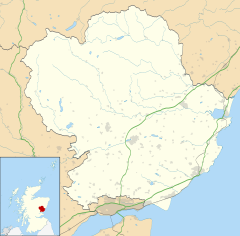Friockheim
| Friockheim | |
|---|---|
| Friockheim shown within Angus | |
| Population | est. 930 (2006) |
| OS grid reference | NO591496 |
| Council area | |
| Lieutenancy area | |
| Country | Scotland |
| Sovereign state | United Kingdom |
| Post town | ARBROATH |
| Postcode district | DD11 |
| Dialling code | 01241 |
| Police | Scottish |
| Fire | Scottish |
| Ambulance | Scottish |
| EU Parliament | Scotland |
| UK Parliament | |
| Scottish Parliament | |
Friockheim /ˈfriːkəm/ is a village in Angus, Scotland dating from 1814. It lies between the towns of Arbroath, Brechin, Forfar and Montrose.
The name 'Friockheim', literally translated, means 'Heather Home', with Friock being a derivative from the Gaelic 'fraoch' (heather) and 'heim' from the German for home. The word 'Friockheim' as a whole, is pronounced 'Free-come'.
The birth of the village took place soon after 1814 when Thomas Gardyne of Middleton succeeded his brother as the laird of the lands of Friock and feued them to Mr John Andson, of Arbroath, who built a flax spinning mill and as proprietor-in-feu attracted many textile workers to come and settle on easy terms in what was at first known as Friock feus.
Mr Andson's son, John Andson added in the 'heim' part of the name. This was at the request of the numerous Flemish weavers who had gone there to develop the flax spinning process. He had to obtain the sanction of Thomas Gardyne as superior and together they agreed on the following advertisement, which is thought of as Friockheim’s foundation charter.
Printed in Arbroath and dated May 22, 1824 this read:
John Andson died in office in 1814 and his mill was burnt to the ground in 1862.
The village of Friockheim now has a population of around 800 - lower than its peak of 1,200 in the early 1900s. It has a convenience store and pharmacy as well as several small businesses and shops. There is also a public park and two village halls as well as a primary school and community centre. It also has its own church, dating from 1835.
It used to be home to Douglas Fraser & Sons (Mfg) Ltd producing waterproof and leisure clothing but this firm no longer exists, and the ground where its mill was situated is now the site of modern housing. Planning conditions require the reinstatement of the mill lade, or at least part of it, with public access.
...
Wikipedia

